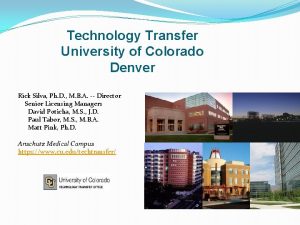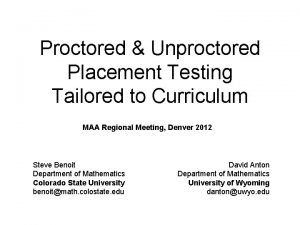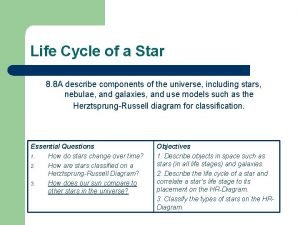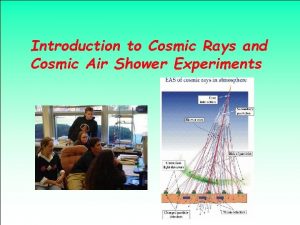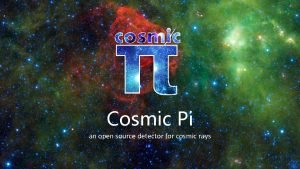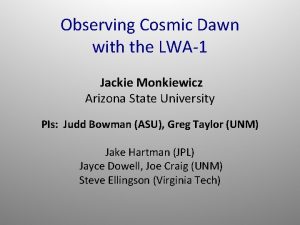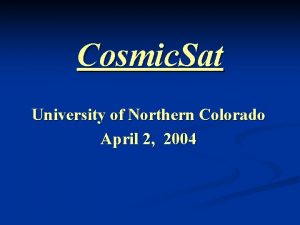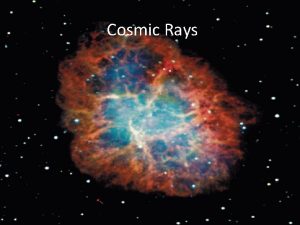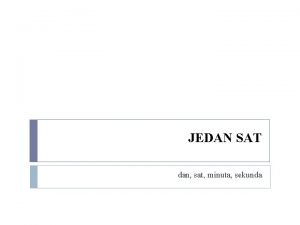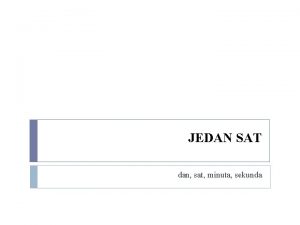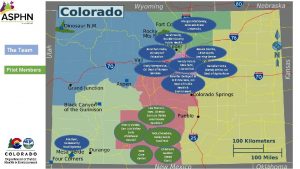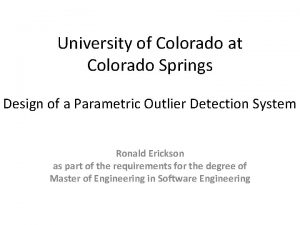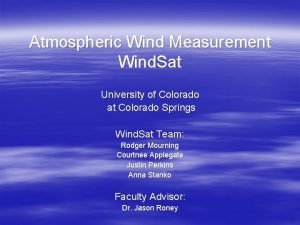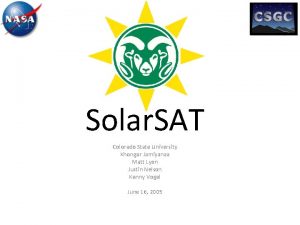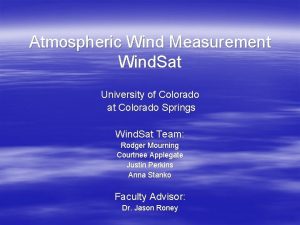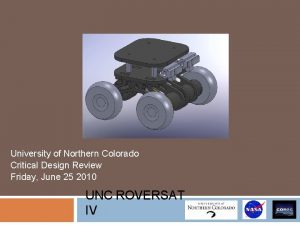Cosmic Sat University of Northern Colorado April 2

























- Slides: 25

Cosmic. Sat University of Northern Colorado April 2, 2004

Cosmic. Sat Goals n Objective: Determine charged particle count with altitude using a coincidence count detector n NASA Benefits: Measure cosmic radiation in a Mars-like atmosphere using a small detector

Cosmic. Sat n System Requirements: n Detectors , coincidence counts circuit, housing, heating circuit and data storage. n Payload mass - ~ 2 kg n Atmospheric temperatures of ~ - 60 degrees F n Large atmospheric pressure differential n Coronal Discharge n Magnetic shielding n Crash survival

Cosmic. Sat: System Overview Scintillator PMT Coincidence Circuit Data Logger Batteries Scintillator Heater Circuit Batteries Switches

Subsystem: PMTs and Scintillator n Purpose: n Scintillator: n n n Interacts with charged particles Excites electrons between molecular bound states Electron de-exitation produces photons Photon travels along scintillator undergoing many total internal reflections Photomultiplier Tubes: n n Collect photons Converts photons to an electronic signal

PMTs and Scintillator n Photomultiplier Tube Module Interfaces: n n n Base encased with PMT High voltage source in base Requires an external 5 V power source Base interfaced with coincidence count circuit Optical grease between PMT face and scintillator Base PMT Head

Charged Particles PMTs and Scintillator Optical Grease PMT Scintillator Vacuum Epoxy n The PMTs bonded to scintillator n Organic Scintillator wrapped in Mylar foil and electrical tape n PMTs wired to coincidence circuit via BNCs

PMTs and Scintillator PVC n BNC Housing: n n n PMTs encased in PVC pipe – maintain atmospheric pressure PMT – scintillator joined with vacuum epoxy and then JB Weld. PVC capped and interfaced with BNCs for wires JB Weld Vacuum Epoxy Scintillator

Housing Prototype

System Stabilization Wood Frame n The two PVC pipes bonded with ABS “glue” n Adds support for all system components n Tether passes through brass tube in center n Each PMT - Scintillator combination slides into frame. Brass Tube

The Exterior Box Materials n Reflective Mylar n Insulation n Foam Core n Thermo. Sheild Paint n Aluminum tape n Epoxy

Coincidence Counting Circuit n Purpose: n To supply each PMT with 5 V n To time impulses from each PMT determine coincidences and n Send count impulses to data logger

Coincidence Timing Circuit Courtesy of Lawrence Berkeley National Laboratory

Circuit System Schematic n Interfaces: n Two PMT Modules n Two nine volt batteries in series n Madge. Tech Data Logger Circuit

Circuit: Start to Finish Courtesy of Lawrence Berkeley National Laboratory

Heater Circuit n Six Resistors – n n Resistors 3. 9 ohm each 5 Watts each n Three 9 Volt batteries in parallel n Keep payload interior > 5 C Batteries in parallel

Power Budget n 18 Volts to the Coincidence Count Circuit n n Power out – heater – 18 watts n n PMT modules High voltage source is housed within the PMT base 9 Volts to the heater circuit (three 9 V batteries in parallel) Current requirments: 1934 m. A n n n Heater - 1450 m. A Circuit – 224 m. A PMT modules – 80 m. A each

Data Collection § Purpose: § Collect electronic pulses from the circuit § Put a time stamp to each pulse

Data Collection Schematic Computer Post-Recovery Data Logger Circuit During Flight

Mass Budget : 3000 gm 2 Scintillator Panels Brass rod Box Frame 2 PMTs Pulse recorder Hobos Batteries Heater Circuit Cables, switches 415 grams 34 grams 600 grams 460 grams 26 grams 61 grams 191 grams 37 grams 145 grams 100 grams Total 2469 grams

Budget PMT Modules ~ 2300. 00 Madge. Tech Data Logger ~ 195. 00 Batteries ~ 100. 00 Box Materials ~ 100. 00 LX 200 ~ 250. 00 Geiger tube ~ 270. 00 Cables ~ 50. 00 Buffing Compound ~ 125. 00 Optical Grease ~ 75. 00 Electronic components ~ 50. 00 Total _____________________ ~3515. 00

Project Organization n Project Advisors: n Electronics: n n n Dr. Robert Walch Dr. Dick Dietz Dr. Cynthia Galovich Dr. Kendall Mallory n n Project Manager: n Data Collection & Heater: n n n Ryan Marshall PMT Module & Scintillator: n Pat Mills Julie Smith Anna Samsel System Housing & Stabilization: n Levi Ellis

Schedule n April 5 – 10: n n n April 11 – 16: n n n Individual component testing Construct the housing and frame Construct the detector Construct the Geiger tube – Palmtop detector Test the whole system Make any final adjustments April 17 : n Launch

Alternate Payload Geiger Tube – Palmtop Computer

Acknowledgements Dr. M. A. Duvernois Dr. James Connell Dr. Howard Matis Andrew Loomis Ken Cochran Kodak University of Minnisota University of New Hampshire Lawrence Berkeley National Laboratory UNC PMTs purchased with Electroptics Grant funds Many Thanks to: The Colorado Space Grant Consortium, NASA and JPL for giving us this wonderful opportunity The UNC Dept. of Physics faculty; without whom, none of this would be possible
 University of eastern colorado firewatch
University of eastern colorado firewatch Colorado state university employee benefits
Colorado state university employee benefits Colorado university
Colorado university University of colorado
University of colorado Unproctored placement assessment
Unproctored placement assessment Jennifer harman colorado state university
Jennifer harman colorado state university Nau family housing
Nau family housing Nau blackboard
Nau blackboard Cosmic conflict definition
Cosmic conflict definition What is a cosmic address
What is a cosmic address Seasky.org cosmic
Seasky.org cosmic Cosmic irony
Cosmic irony Structural irony
Structural irony What is irony
What is irony Cosmic ray showers
Cosmic ray showers Trope examples
Trope examples Cosmic rays discoverer
Cosmic rays discoverer Cosmic ray elab
Cosmic ray elab Cosmic pi
Cosmic pi Cosmic link östergötland
Cosmic link östergötland What is cosmic education
What is cosmic education Cosmic superclass in java
Cosmic superclass in java Radar ranging
Radar ranging Initial answer
Initial answer What is our cosmic address
What is our cosmic address Jackie smith cosmic
Jackie smith cosmic



